Antique Spice, Tobacco, & Other Tins
Signs and tins are probably the two most popular areas of antique advertising collecting. We have hundreds of different tins pictured below. It is easy to see why these antique tins are popular and valuable. The colors and designs are all extremely attractive. Antique tins are fun to collect whether you are looking to spend $1,000 on a collection or $100,000.
Most all of these tins were being sold in country stores in the days before radio, television, and print advertising. If a company (tobacco or otherwise) wanted a consumer to be aware of a product, then the company’s only chance to pitch its product was at the actual time of sale. This often meant that the brightest and loudest tin would get the most attention and therefore get purchased. Some manufacturers relied less on color and more on regional or personal affiliations to hit home.
All things equal, a rare tobacco tin will be worth more money than something equally rare that is a coffee, spice, or other tin product. The collectability of tobacco tins is twofold. Most of them are a uniform size (when talking about pocket tins). Someone could conceivably collect 100 different tobacco tins all of the same size and make a beautiful display. Tobacco tins are also popular because they fall neatly in with other areas of tobacciana like signs, pipes, and store displays. You could put together a pocket tin, store bin, and sign all for the same brand. I think it is also fair to say that the tobacco market was the largest and most competitive area of many country stores. Tins came and went quickly if they weren’t selling. Some tins could be unique and others could be one of tens of thousands known to exist. There is a real thrill of the hunt associated with tobacco tins that just isn’t present with other tins. We should also mention that cigar tins are closely associated with tobacco tins. Cigar tins can be equally valuable and rare.
Non-tobacco tins can still be extremely rare and collectible. These tins are usually for coffee, spices, talc, cocoa, tea, gum, and even condoms. These aren’t quite as collectible just because the offering is too diverse. Some of the areas are just too esoteric to get a following together to make prices competitive like tobacco tins. There are also fewer reference books on the subject, so the market just isn’t quite as sophisticated.
So What’s Rare? There is no short way to list all the rare tobacco and other tins. For a tin to be valuable it doesn’t necessarily have to be extremely rare. Condition is very important. A relatively scarce tobacco tin might be worth $750 in absolutely perfect condition. The same tin in poor condition might only be worth $75. Before you try to value your tin it is important to understand the different conditions that affect value. Furthermore, especially with tobacco tins, there are varieties of the same tin that might make one especially rare and one common. Phrasings and moderate design changes are the factors that usually affect values within the same tin.
So What’s in Demand? With so many tins out there how is a new collector to know what’s valuable and rare and what’s just another tin? First, go to swap meets and antique shows so you can recognize the very common tins like Prince Albert or Sir Walter Raleigh, the medium rarity tins or common varieties of tins. Talk to other collectors and dealers to learn what the rare variations are and what people find desirable. Every collector is different and some focus on specific manufactures, themes, or can makers. Things that are always in demand: condition (top grade tins of anything except the most common always have a market), age (older tins made by companies like Somers Bros. or Ginna & Co. are always in demand), and interest of graphics (tins like the famous Taxi tin, or Game Bird tin have excellent graphics that always have collectors pulling out their wallets).
If you want to find out how much your tin is worth, then just ask us. All of our information is free and we answer emails usually within an hour or less. Just send a few pictures of your tin and we can go from there. We look forward to hearing from you.
-
 Deep Rock Motor Oil Round Metal Cans
Deep Rock Motor Oil Round Metal Cans -
 Double Eagle Motor Oil Rectangle Metal Can
Double Eagle Motor Oil Rectangle Metal Can -
 Eldred Motor Oil Flat Metal Can
Eldred Motor Oil Flat Metal Can -
 Five Motor Oil Round Metal Cans
Five Motor Oil Round Metal Cans -
 French Auto Oil Flat Metal Can
French Auto Oil Flat Metal Can -
 Frontier Motor Oil Round Metal Can
Frontier Motor Oil Round Metal Can -
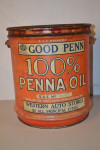 Good Penn Motor Oil Round Metal Can
Good Penn Motor Oil Round Metal Can -
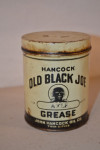 Hancock Round Grease Can
Hancock Round Grease Can -
 Heccolene Oils Flat Metal Can
Heccolene Oils Flat Metal Can -
 Hi-temp Motor Oil Round Metal Can
Hi-temp Motor Oil Round Metal Can -
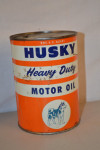 Husky Motor Oil Round Metal Can
Husky Motor Oil Round Metal Can -
 Kerr Mcgee Handy Oilers
Kerr Mcgee Handy Oilers -
 Kerr Mcgee Round Fiber Cans
Kerr Mcgee Round Fiber Cans -
 Keystone Grease Can And Pennzoil Can
Keystone Grease Can And Pennzoil Can -
 Mccoll-Frontenac Grease Can
Mccoll-Frontenac Grease Can -
 Mccormick-Deering Flat Metal Can
Mccormick-Deering Flat Metal Can -
 Monogram Motor Lubricants Squatty Metal Can
Monogram Motor Lubricants Squatty Metal Can -
 Motor Oil Round Fiber Cans
Motor Oil Round Fiber Cans -
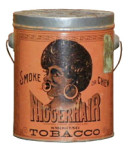 Niggerhair Tobacco Tin
Niggerhair Tobacco Tin -
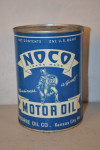 Noco Motor Oil Round Metal Can
Noco Motor Oil Round Metal Can -
 Packard Round Metal Can
Packard Round Metal Can -
 Pennzoil Motor Oil Square Metal Can
Pennzoil Motor Oil Square Metal Can -
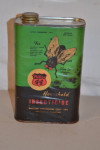 Phillips 44 Insecticide Metal Can With Paper Label
Phillips 44 Insecticide Metal Can With Paper Label -
 Phillips 66 Motor Oil Round Metal Cans
Phillips 66 Motor Oil Round Metal Cans -
 Selwin Motor Oil Metal Can
Selwin Motor Oil Metal Can -
 Shamrock Oil Metal Cans
Shamrock Oil Metal Cans -
 Six Motor Oil Round Metal Can
Six Motor Oil Round Metal Can -
 Texaco Marine Motor Oil Round Metal Cans
Texaco Marine Motor Oil Round Metal Cans -
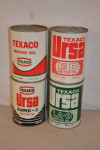 Texaco Motor Oil Round Metal Cans
Texaco Motor Oil Round Metal Cans -
 Vita Power & Cascade Motor Oil Rectangle Metal Cans
Vita Power & Cascade Motor Oil Rectangle Metal Cans